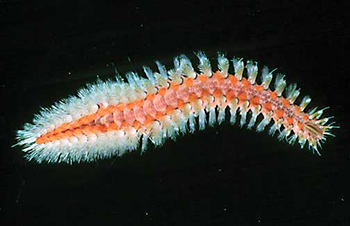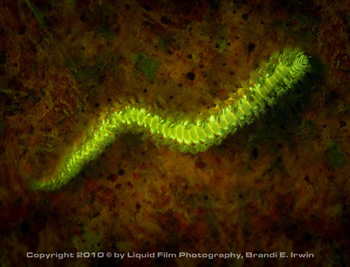Fireworm
Hermodice carunculata

Taxonomy
Kingdom – Anamalia
Phylum – Annelida
Class – Polychaeta
Order – Aciculata
Family – Amphinomidae
Species – carunculata
Appearance and Behavior
The average Fireworms are usually between 5-10 centimeters in length, but can reach up to 35 centimeters. On both sides they are endowed with a group of poisonous white bristles that flare out when the worm is disturbed. The bristles are hollow, venom-filled chaeta which easily penetrate flesh and then break off if this worm is handled. They produce an intense burning irritation in the area of contact, hence the common name of the species. The sting can also lead to nausea and dizziness. This sensation lasts up to a few hours, but a painful tingling can continue to be felt around the area of contact. They are often strikingly beautiful and very colorful and, unlike the other two groups of annelids. Apart from the head and terminal segments, all the segments are identical, each with a pair of flattened, fleshy lobe like paddles called parapodia, which are used for swimming, burrowing and creating a feeding current. These worms assume a defensive posture, arching its body dorsally to display expansive fascicle of harpoon chaetae when disturbed. They are active during the night and usually hidden during daytime.
Habitat/Range
These worms are abundant on reefs, beneath stones in rocky or sea grass areas and on some muddy bottoms. They have also been found at or near the surface in flotsam and can occur to at least 60m. They are found throughout the tropical western Atlantic as well as the mid-Atlantic. It can be found near ocean reefs and at depths of up to 150m. These worms are also common in the Mediterranean Sea, and in the coastal waters surrounding Cyprus and the Maltese archipelago.
Food
Fireworms are predators that feed on soft and hard corals, anemones, and small crustaceans. They engulf the last few centimeters of the tip of a branching coral inside its pharynx and remove the coral tissue right from the skeleton. On average they spend around 10 minutes at each coral location. Where they have been feeding is visible due to the lack of color on the coral. Although the Fireworm prefers the tissue of Cnidarians, they will readily accept and thrive on alternative foods in captivity. These include: squid, clam, shrimp, krill, shrimp, and mussels.
Reproduction
Fireworms exhibit both asexual and sexual reproduction. Asexual reproduction occurs when individuals undergo fragmentation, dividing the body into one or more parts that regenerate to form heads tails or both, and grow into new individuals. The most well know trait of the Fireworm is there bioluminescence during sexual activity. Spawning usually occurs 2-5 days after a full moon.
Ecological Impact
These annelids do not differ from the other annelids impact that they have on the environment. They convert organic ocean debris into carbondioxide, which is then used by the plankton to help with photosynthesis. They aren’t a threat to humans unless a careless diver swims to close and brushes against their bristles. These segmented worms are very rarely found in aquariums due to their hostile tendencies.
Recent Research
Marine Fireworms use bioluminescence to attract suitors in an undersea mating ritual. Research conducted by Scripps marine biologists reveals that the worms also may use the light as a defensive measure. The report, published as the cover story of the current issue of the journal Invertebrate Biology, provides insights into the function of Fireworm bioluminescence and moves scientists closer to identifying the molecular basis of the light. This brings scientists closer to being able to isolate the protein that is causing the light. If they can understand how it is possible to keep light so stable for such a long time, it would provide opportunities to use that protein or reaction in biomedical, bioengineering and other fields-the same way other proteins have been used.
Personal Interest
I’ve never heard of the Fireworm or seen an animal quite like it. Immediately it caught my interest with its name, how the setae sting, and the bioluminescence.
References
http://www.botany.hawaii.edu/basch/uhnpscesu/htms/kahoinvr/images/amphin/k044x7.jpg
http://www.uwphotographyguide.com/images/birwin-uv-light-5.jpg
"Fire Worms." Fire Worms. Web. 30 May 2012.< http://www.reefersparadise.com/smf/index.php?topic=495.0>.
"Bearded Fireworms, Hermodice Carunculata." At MarineBio.org. Web. 29 May 2012. <http://marinebio.org/species.asp?id=292>.
":: SCRIPPS OCEANOGRAPHY NEWS : : Scripps Scientists Help Decode Mysterious Green Glow of the Sea ::." :: SCRIPPS OCEANOGRAPHY NEWS : : Scripps Scientists Help Decode Mysterious Green Glow of the Sea ::. Web.31 May 2012.< http://scrippsnews.ucsd.edu/Releases/?releaseID=970>.
